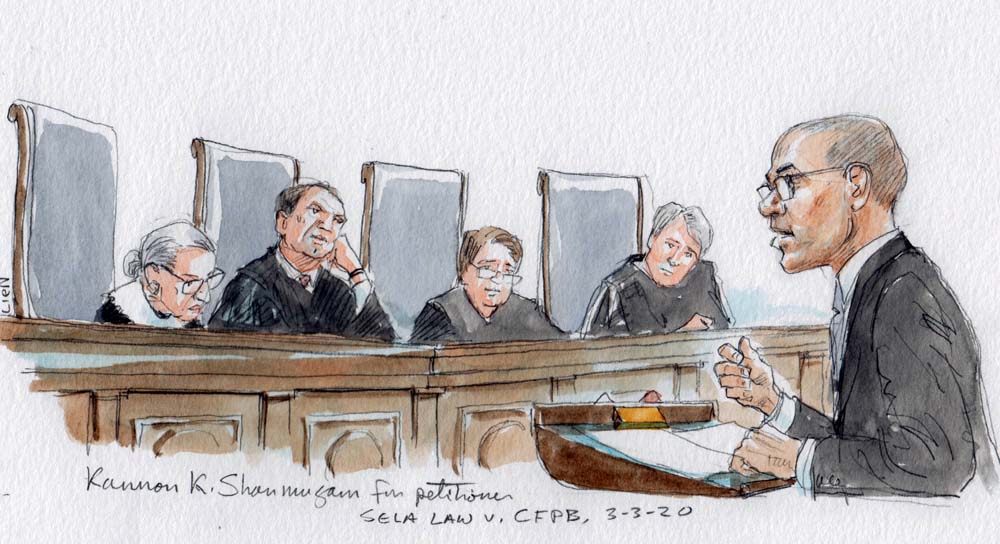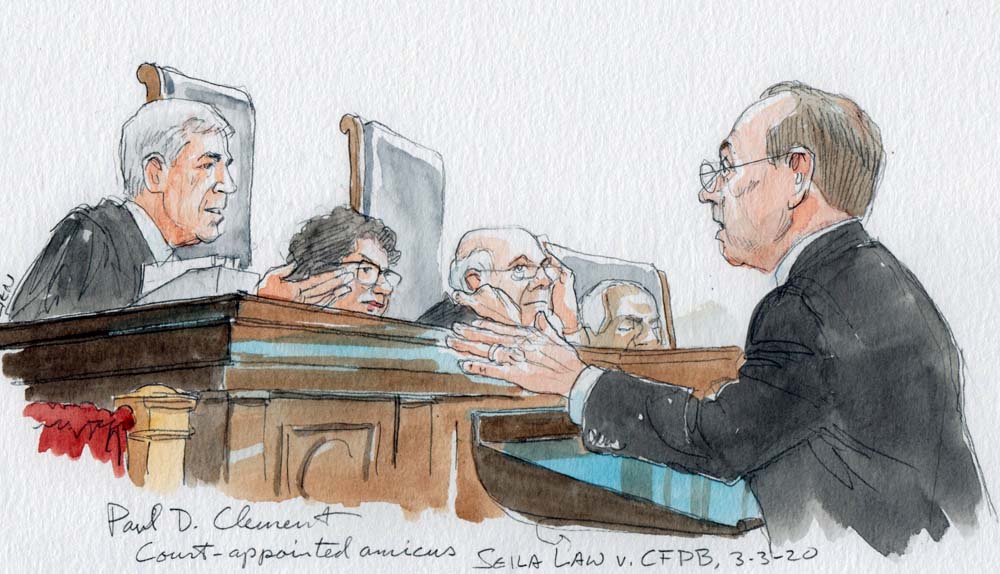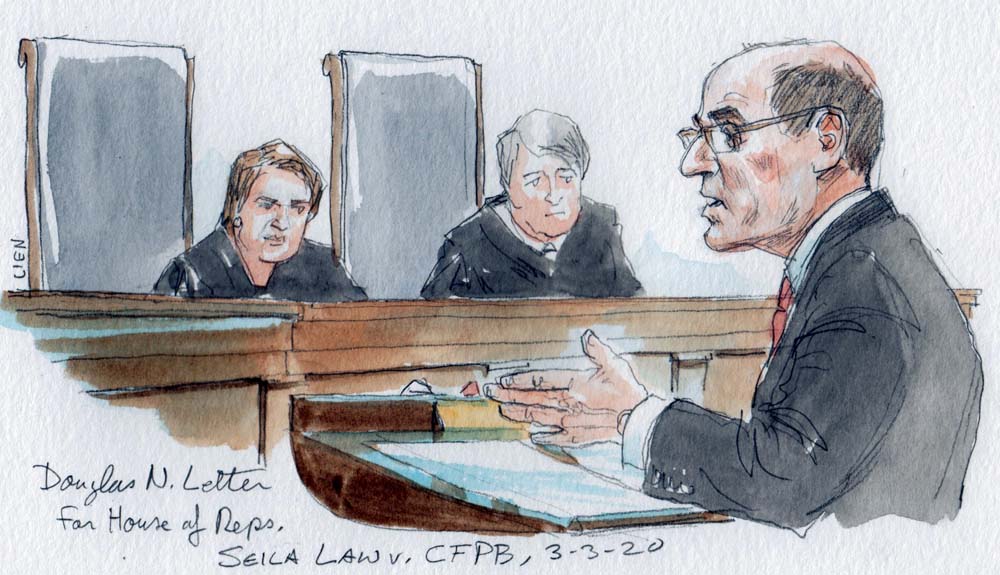Argument analysis: Justices divided in challenge to CFPB structure


The Consumer Financial Protection Bureau is headed by a single director, who is appointed by the president and confirmed by the Senate to serve a five-year term. Once that director is in office, she can only be removed by the president for “inefficiency, neglect of duty, or malfeasance in office.” This morning both a California law firm under investigation by the CFPB and the CFPB itself told the Supreme Court that these restrictions on the removal of the bureau’s director are unconstitutional. If the justices agree, they must then decide what the remedy should be for the constitutional violation. The fate of the CFPB, as well as other agencies with similar structures, could hinge on their answer.

The dispute before the Supreme Court today began when the CFPB started an investigation into whether Seila Law, which provides debt-relief services to consumers, violated telemarketing sales rules. Seila Law refused to respond fully to the CFPB’s request for information and documents, prompting the agency to go to federal court in California to enforce the request. Seila Law argued that the CFPB lacked authority to issue the request. Specifically, the law firm contended, the CFPB’s structure is unconstitutional because it is led by only one director, who wields significant power but can only be removed “for cause” rather than “at will” – that is, for any reason.
The lower courts disagreed and upheld the agency’s request for information and documents. Seila Law then asked the Supreme Court to take up the question, which it agreed to do last fall. Because the CFPB agreed in its Supreme Court briefs that the bureau’s structure is unconstitutional, the justices appointed former U.S. solicitor general Paul Clement to defend the ruling of the U.S. Court of Appeals for the 9th Circuit.
Arguing for Seila Law, lawyer Kannon Shanmugam told the justices that the leadership structure of the CFPB is “unprecedented and unconstitutional.” The Constitution, he emphasized, empowers the president to keep senior government officials accountable by being able to remove them at will.
Justice Ruth Bader Ginsburg was skeptical about whether the justices needed to weigh in on the constitutionality of the CFPB’s structure at all. “This case,” she told Shanmugam, has an “academic quality” about it because the bureau’s request for information was ratified by the acting director, who can be removed by the president for any reason. How, Ginsburg asked, does the composition of the CFPB affect Seila Law?
Shanmugam countered that there is still a live dispute because Seila Law wants to have the request for information invalidated, while the government is seeking to enforce it. If anything, he asserted, that would be an issue for the lower courts to consider on remand.
Sotomayor also wondered aloud whether the justices needed to decide the merits of the case. Your client is not the president, she told Shanmugam. Shouldn’t we wait, Sotomayor queried, until there is an actual dispute between the president and the CFPB director whom he wants to fire?
Sotomayor also took issue with Shanmugam’s contention that the CFPB’s structure is “unprecedented.” There are at least two other agencies that are headed by a single individual and have limits on the president’s ability to remove them, she noted: the Office of Special Counsel and the Social Security Administration. And in her view, the Social Security Administration is even more powerful and ubiquitous than the CFPB.
Shanmugam pushed back, telling Sotomayor that the level of executive power that the CFPB wields is unprecedented because – unlike the SSA – it is able to take enforcement action.
Arguing for the CFPB, U.S. Solicitor General Noel Francisco told the justices that, as a general rule, the president has the “unrestricted authority” to remove senior government officials. Francisco acknowledged that the Supreme Court’s 1935 decision in Humphrey’s Executor v. United States, in which the justices rejected the argument that the structure of the Federal Trade Commission, with five commissioners who could be removed only for cause, was unconstitutional, is an exception to that rule, but he urged the justices not to extend the exception. Doing so would lead to two problems, Francisco emphasized. First, there would be no “coherent limiting principle,” creating the possibility that the president’s ability to remove even members of his own cabinet could be limited. Second, it would sever executive power from political accountability. The president stands for election, Francisco stressed, while the director of the CFPB does not.
Justice Elena Kagan dismissed efforts by Shanmugam and Francisco to distinguish between the multimember commission in Humphrey’s Executor and the single director in this case as “simplistic.” It “all depends” on the agency, Kagan posited. She returned to this point a few minutes later, telling Francisco that even if you can generalize about multimember commissions and single-director agencies, the conclusions about agency independence actually cut the other way. It would be much harder for the president to influence a multimember commission than a single-director agency, Kagan suggested. It would be “easier for the president to get one person on the phone than seven,” she said.

Defending the 9th Circuit’s ruling that the CFPB’s structure is constitutional, Paul Clement tried to assure the justices that upholding the structure would not have as sweeping an effect as Francisco had predicted. Among other things, Clement emphasized, the Constitution would prevent Congress from imposing more restrictive removal provisions for some parts of the president’s cabinet, such as the Departments of State and Defense.

Arguing on behalf of the U.S. House of Representatives, which filed a “friend of the court” brief to defend the CFPB’s structure, Douglas Letter also attempted to calm the justices’ concerns. The House has never tried to have cabinet members be anything other than removable “at will” by the president, he pointed out.
Several justices focused on the text of the removal restriction at the center of the dispute, which only allows the president to remove the director for “inefficiency, neglect of duty or malfeasance in office.” Ginsburg suggested that the restriction is a “very modest restraint” that stops the president from removing the CFPB director on a “whim,” replacing her with someone loyal to the president rather than someone who will protect consumers.
Shanmugam responded that the CFPB removal restriction was “never understood as a modest one.” There is “abundant evidence,” he told the justices, that Congress wanted to create an agency that would be insulated from political control to the fullest extent possible – which it wanted to accomplish by making it difficult for the president to remove the CFPB director.
Chief Justice John Roberts observed that the Supreme Court’s normal practice of trying to avoid deciding constitutional questions might suggest that the court should scrutinize how stringently the “inefficiency, neglect of duty, or malfeasance” standard should actually be interpreted. A term like “inefficiency,” Roberts noted, could be interpreted expansively to set a relatively low bar – closer to an “at will” standard than a “for cause” standard.
But both Letter and other justices were less enthusiastic about such an interpretation. Justice Brett Kavanaugh, who as a judge on the U.S. Court of Appeals for the District of Columbia Circuit would have ruled in a different case that the CFPB’s structure is unconstitutional, expressed concern that a “watered down” standard would make other agencies with similar removal restrictions less independent.
Justice Neil Gorsuch also seemed uninclined to adopt such an interpretation, asking Clement to explain the difference between “watering” the standard down and “being honest about what we’re doing” by overruling Humphrey’s Executor.
Even Roberts himself seemed to have a change of heart by the end of the argument. If the standard is more flexible, he told Clement, it will lead to litigation over whether it has been met, which will be the “worst of all possible worlds.”
There was no clear consensus – among either the parties or the justices – on what the court should do if a majority of the justices conclude that the CFPB’s structure is unconstitutional. Kavanaugh pointed to the text of the Dodd-Frank Act, which created the CFPB and which contains a severability clause – a specific provision indicating that if one part of the act is ruled unconstitutional, the rest of the act still survives. Wouldn’t we be rewriting the Dodd-Frank Act, Kavanaugh asked, if we didn’t heed the severability clause?
The Supreme Court has made clear, Shanmugam answered, that severability clauses only create a presumption of severability. And here, Shanmugam told the justices, that presumption is “a weak one.” Kavanaugh pushed back, reminding Shanmugam that the cases to which he was referring date back to “an era in which we didn’t pay as much attention to text.” But Shanmugam didn’t back down, telling the court that it should have “serious pause” about giving the president “complete control” over the CFPB because it is not what Congress would have wanted.
Describing the severability clause as “clear and unambiguous,” Francisco depicted the question as a “very easy” one. There is no need to engage in “navel-gazing” about what Congress would have done, he told the justices, because the severability clause makes that question clear. And he stressed the importance of resolving the severability question; otherwise, he emphasized, “then there really is a cloud hanging over everything that the CFPB does.”
Although disagreeing with him on the merits, Letter echoed Francisco’s position on severability. If the removal restrictions are unconstitutional but are not separated from the rest of the law creating the CFPB, Letter warned, it will not be a simple scenario. The functions that the CFPB serves came from seven different agencies, some of which no longer even exist.
After over 70 minutes of argument, it was hard to predict exactly how the court will decide the case. There seemed to be relatively little appetite, beyond Ginsburg and Sotomayor, for dismissing the case without deciding the merits, as Clement suggested. The most likely scenario seems to be that a majority on the court will conclude that the CFPB structure is unconstitutional but will allow the CFPB itself to survive. We won’t know for sure until the decision is released sometime this summer.
This post was originally published at Howe on the Court.
Posted in Merits Cases
Cases: Seila Law LLC v. Consumer Financial Protection Bureau